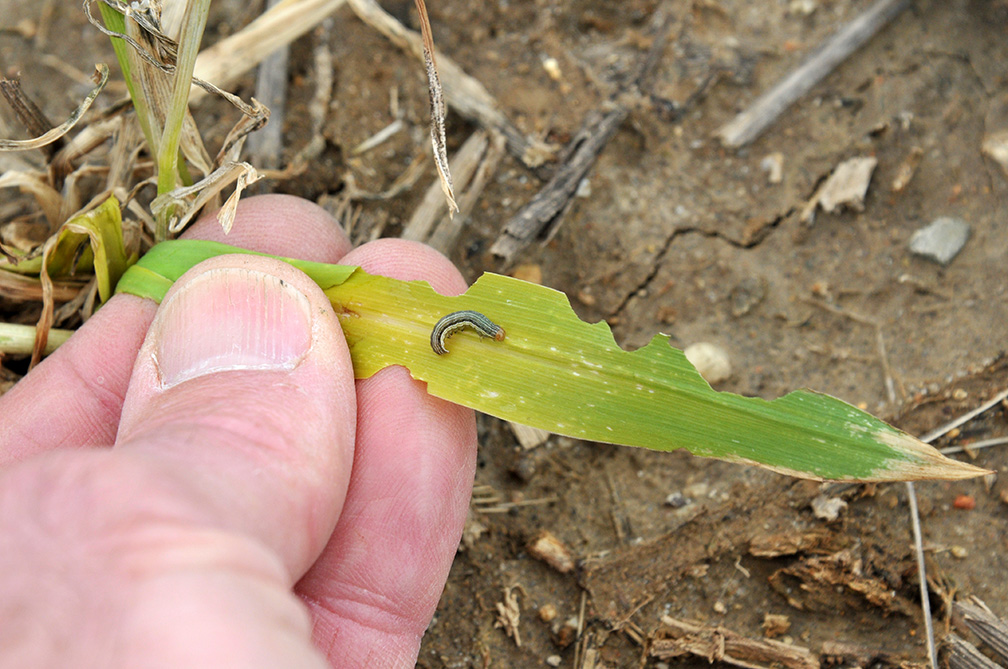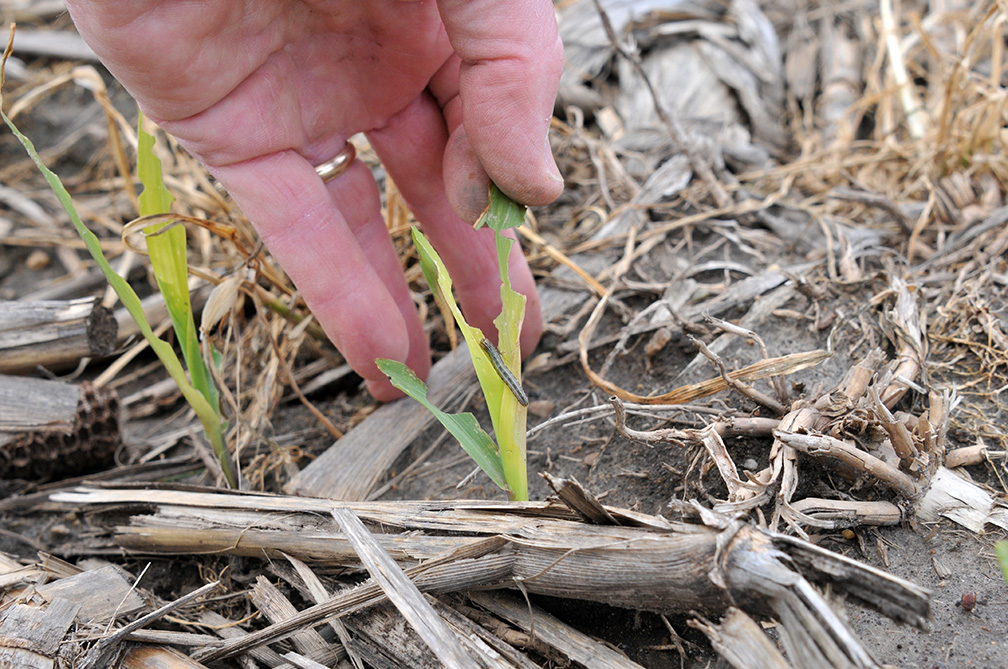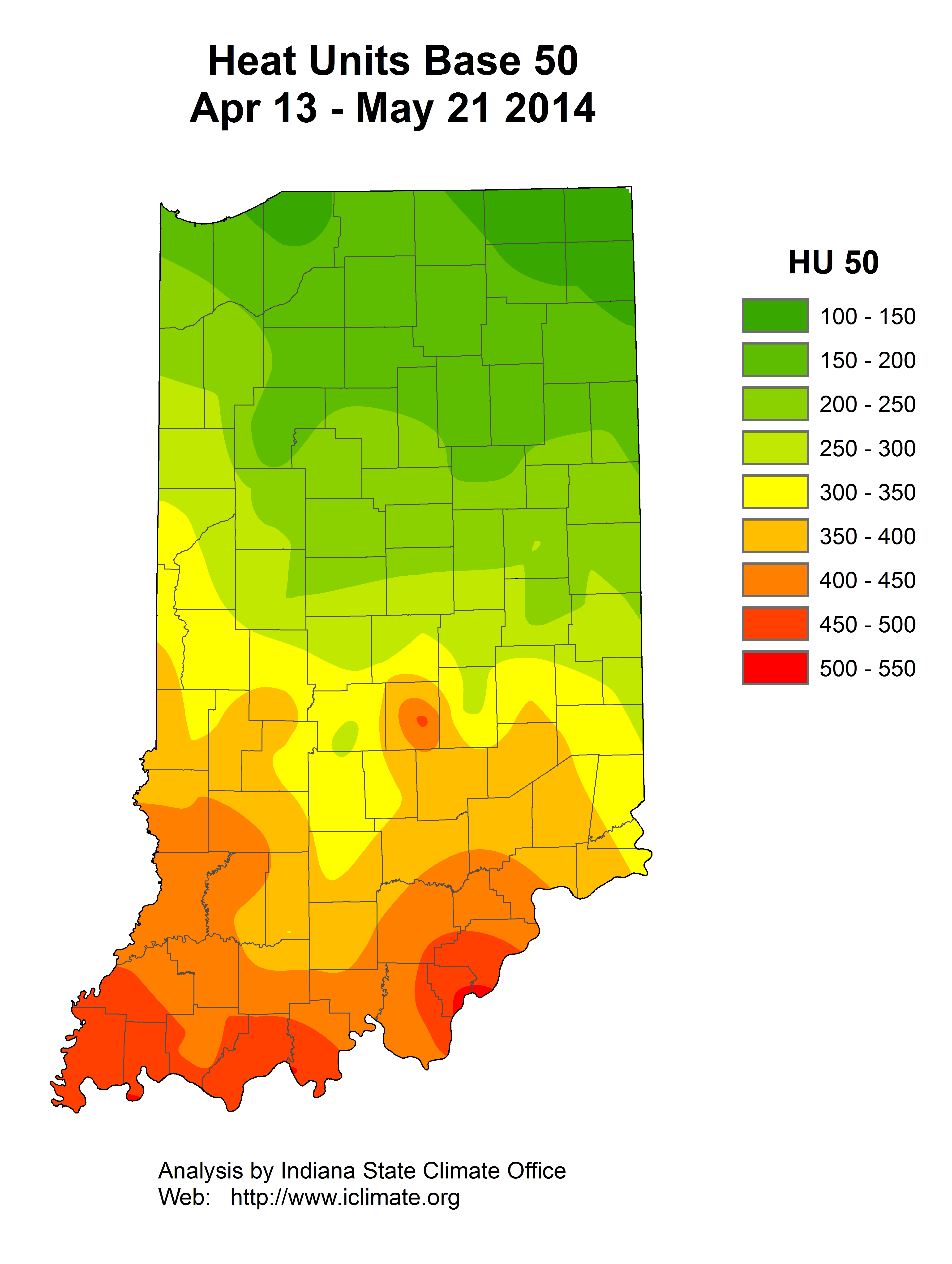USDA-NIFA Extension IPM Grant
Pest & Crop Newsletter, Entomology Extension, Purdue University
- Armyworm Active in High-Risk Corn Fields
- Black Cutworm Development Map
- Armyworm Pheromone Trap Report
Armyworm Active in High-Risk Corn Fields – (Christian Krupke and John Obermeyer)
- Armyworm moth captures have not been high, but they have concentrated their egg-laying to specific fields
- High-risk crops are corn fields following grasses, especially rye cover crop.
- Some Bt corn may suppress but not control armyworm.
Seed-applied insecticides offer
no help.
A random inspection of a 2-leaf cornfield, no-tilled into
a burned down grassy cover crop in west central Indiana
revealed some armyworm leaf feeding (see accompanying
pictures). While carefully looking under crop/cover debris,
armyworm larvae about a ˝ inch long were found. Because
armyworm primarily feed at night, careful searching in the
vicinity of damaged plants in necessary to find these small
larvae. Initially the damage appears negligible to the plant,
but as the armyworm increase in size, so does their appetite.
These small larvae are easy to treat/kill with insecticides, the
larger ones are not as easily controlled!
High-risk crops are those where dense grassy vegetation
(e.g., wheat, grass hay, grass cover crops) still exist have
generally been burned-down for planting. Corn that has been
no-tilled into a grass cover crop (ESPECIALLY ANNUAL
RYE) should be inspected immediately for armyworm
feeding. Hatched larvae will move from the dying grasses
to emerging/emerged corn. There is nothing that resembles
armyworm feeding at this time of year - armyworm feeding gives corn a ragged appearance, with feeding extending
from the leaf margin toward the midrib. Depending on the
armyworm population, most of the plant can be consumed.
Severe damage is often compared to pencils sticking out of
the ground.
Don’t be complacent
with Bt corn hybrids, as high
armyworm infestations will
still cause significant damage
before the insecticidal proteins in Bt corn
reduce their feeding. Seed-applied insecticides, even highrates,
will NOT control armyworm. In short, there is no inplant
or on-seed solution that will allow you to avoid scouting
on this one. Remember, once armyworm larvae reach an
inch or more in length, they eat a tremendous amount of
foliage in a short period of time and become harder to kill.
Large areas of seedling corn can be wiped out overnight
under heavy infestations.
Sweet dreams and happy scouting!

High Risk Field, Corn Emerging in Burned Down Cereal Rye

Characteristic feeding
damage from small
armyworm

Small armyworm on damaged leaf

This armyworm remained
feeding during the day
![]()
Bug Scout says: "Keep your
eye out for black cutworm
damage in high-risk fields."
![]()
Click here to see the Armyworm Pheromone Trap Report
Corn Growth, Postemergent Herbicides, and Crop
Injury – (Bill Johnson and Travis Legleiter)
The majority of Indiana’s corn went into the ground the week
of May 4th-9th with ideal weather and soil conditions. Although
that week also came with lots of high wind speeds that kept
herbicide applicators out of the field and was followed by a week
of rain. It is very likely that a majority of the corn is now emerging
without receiving their planned pre-emerge herbicide application.
Fortunately many of the pre-emerge products can also be applied
postemerge and there are many herbicides for postemergence
weed control in corn. The large number of products is a positive
when considering glyphosate-resistance management and
prevention, but can also make timing and product application
decisions more complicated since corn ear development can
be greatly influenced by postemergence herbicides if they are
applied too late in the growing season.
When choosing a post applied corn herbicide or herbicide
combination, producers need to consider the weed species
present, weed heights, AND crop growth stage. The majority
of conventional post-applied corn herbicides are effective on
select weed species and only at certain weed heights. Typically a
combination of products or a pre-package of active ingredients is
needed to achieve control of all weed species present. Producers
should refer to herbicide labels for weed species controlled
and recommended application heights; Table 4 of the Indiana
and Ohio Weed Control (https://mdc.itap.purdue.edu/item.
asp?Item_Number=WS-16-W#.U3Ylwl5GfIF) Guide can also
assist in choosing an effective herbicide option. Spraying weeds
that are larger than the recommended label height can result in
poor weed control.
The stage and height of corn at the time of post herbicide
application is also important to keep in mind as applications
outside of the labeled window can result in crop injury and/or
yield loss. The type and amount of injury from an application
beyond the labeled window is dependent upon the herbicide,
other environmental stresses, and exact timing of application.
Injury symptoms include: ear pinching, ear bottlenecking,
internode stacking, onion leafing, rat tailing, brace root
malformation, and green snap. Refer to the herbicide label and
Table 6 for the appropriate crop stages for post emergence
herbicide applications. When tank mixing products, follow the
most restrictive label as far as determining the appropriate crop
growth stage restriction.
Other items to consider to avoid crop injury based on our
past experience:
- Avoid using contact herbicides just prior to rain showers or applying these herbicides when there is a heavy dew to avoid washing the herbicide down into whorl.
- Avoid applying growth regulator herbicides after several nights of cool temps (45 degrees or cooler).
- Do not use UAN solutions as the carrier when applying atrazine premixes to spike stage corn.
- Do not mix growth regulator herbicides with chloroacetamide herbicides and apply postemergence. These mixtures are fine if applied before corn emergence.
- Do not apply ALS inhibitors past the V6 stage of corn growth.
Fusarium head blight (scab) management in wheat – (Kiersten Wise)
Wheat will be flowering (Feekes 10.5.1) in parts of
central and southern Indiana this week and next week. As
wheat approaches flowering (Feekes 10.5.1, Figure 1) it is
important to consider the risk for Fusarium head blight, or
scab, development.
The fungus that causes head scab, Fusarium
graminearium, infects wheat during flowering, beginning
at Feekes 10.5.1. Symptoms appear later in the season
and include bleached spikelets on the head (Figure 2),
and small or shriveled grain kernels, commonly called
“tombstones”. The fungus also produces mycotoxins, such
as deoxynivalenol, or DON, which can accumulate in the
infected grain.

Feekes
10.5.1, or
beginning
flowering of
the wheat
plant
A risk assessment tool is available to assess the risk of Fusarium head blight in Indiana as wheat enters flowering. This model can be accessed through the following link: http://www.wheatscab.psu.edu/. This model uses weather information including temperature, rainfall, and relative humidity to calculate risk levels for Fusarium head blight. Although it is a good tool for predicting risk, it has an estimated accuracy level of 80. Keep in mind that the model does not provide a guaranteed prediction for whether or not scab will occur in individual fields, and additional factors such as the local weather forecast, crop conditions, and Extension commentary should be considered when assessing the level of risk. Producers can sign up for alerts courtesy of the U.S. Wheat and Barley Scab Initiative. Alerts can be sent to a cell phone or email, and will be sent out as the risk map updates risk of scab in Indiana. To sign up for alerts, visit: http://scabusa.org/fhb_alert.php.
Bleached
spikelets
symptomatic of
Fusarium head
blight
![]()
VIDEO: Soybean Seedling, Sampling and Submission for Problem Diagnosis - (Kiersten Wise, Gail Ruhl, and John Obermeyer)
When sustained cool and wet conditions occur after soybean planting, emergence and stand establishment problems often follow. These issues may be due to one or more factors including seedling blights, herbicide injury, or excess moisture. It is very difficult to diagnose the cause of stand establishment issues in the field, and to accurately determine the specific organism responsible for seedling blight it is necessary to submit samples to a diagnostic lab such as the Purdue Plant and Pest Diagnostic Lab. This video will demonstrate how to sample fields and submit samples to determine what may be to blame for uneven stands.
VIDEO: Soybean Seedling, Sampling and
Submission for Problem Diagnosis
![]()
Sign up for Purdue Crop Scouting Competition – (Kiersten Wise and Corey Gerber)
The first annual Purdue Crop Scouting Competition will
be held on August 19th at the Purdue Diagnostic Training
and Research Center (DTC) at the Agronomy Center for
Research and Education (ACRE) in West Lafayette, IN
Indiana high school student teams of 4-6 individuals,
and adult team leaders are eligible to participate in the
competition. The primary goal of the Crop Scouting
Competition is to educate youth about agriculture and
Integrated Pest Management (IPM) concepts.
Teams will participate in field scouting exercises in both
corn and soybeans. These exercises will focus on basic
crop agronomics, pest ID (weeds, insects, diseases) and the
decision making processes for improved crop management.
There will also be a general knowledge test associated with
the competition. Each scouting exercise and the test will be
scored, and prizes awarded to the top three teams with the
highest scores. The first place team will receive $500, with
second and third place teams receiving $300, and $150,
respectively.
All groups are welcome. Teams can be supervised by
industry members, Extension educators, K-12 Agriculture
educators, FFA crop judging teams and other FFA groups,
or 4-H groups.
The competition will begin in the morning and conclude
with a provided lunch.
The 2014 competition will be limited to 6 teams. Funds
are available to help with lodging costs for teams. Teams
must register by July 1st, 2014 by contacting Lisa Green at
lgreen06@purdue.edu.
For more information and resources for team training
can contact Kiersten Wise at kawise@purdue.edu.
The competition is supported by the Indiana Soybean
Alliance and the Indiana Corn Marketing Council.




